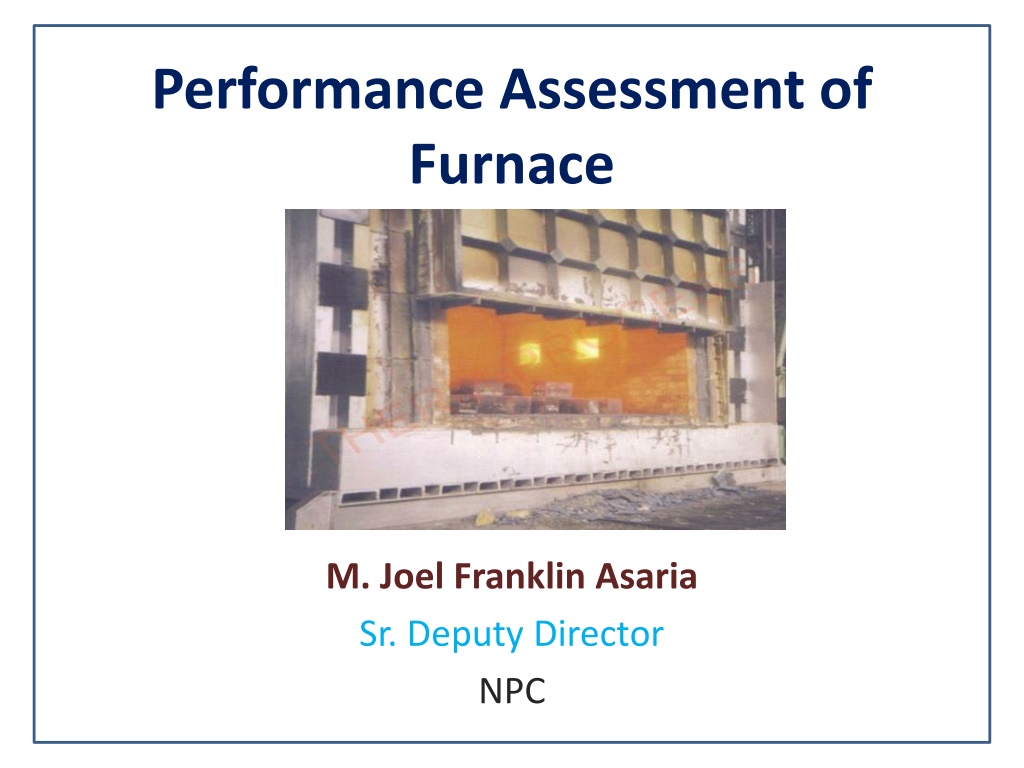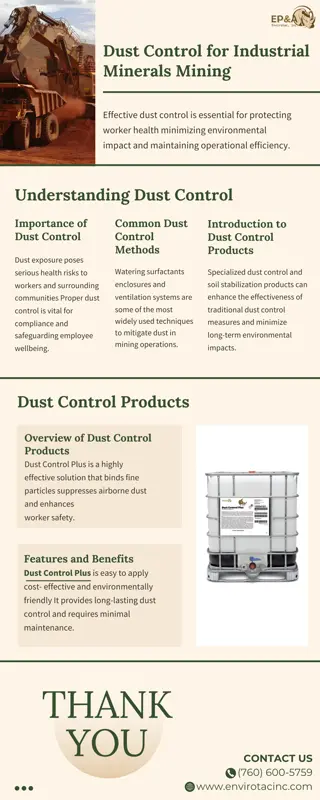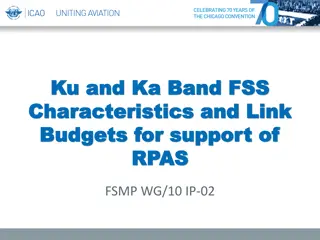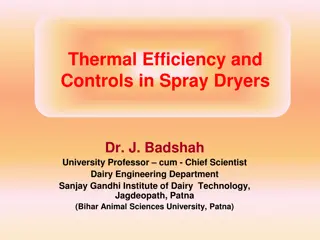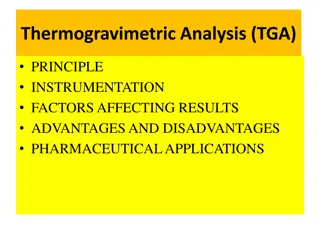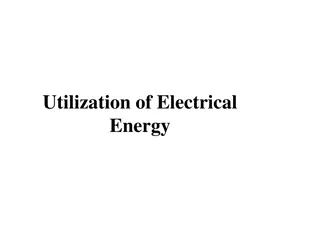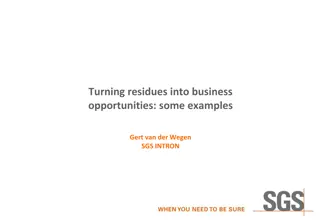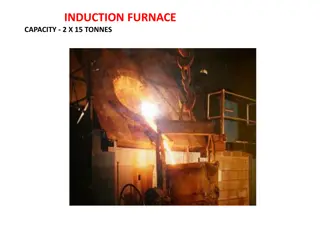Understanding Furnace Performance and Efficiency in Industrial Operations
Explore the performance assessment and operation of various furnace types including forging furnaces. Learn about heat transfer mechanisms, measurement parameters, and furnace efficiency calculations. Discover thermal efficiencies for common industrial furnace setups to optimize energy consumption.
Download Presentation

Please find below an Image/Link to download the presentation.
The content on the website is provided AS IS for your information and personal use only. It may not be sold, licensed, or shared on other websites without obtaining consent from the author. Download presentation by click this link. If you encounter any issues during the download, it is possible that the publisher has removed the file from their server.
E N D
Presentation Transcript
Performance Assessment of Furnace M. Joel Franklin Asaria Sr. Deputy Director NPC
Forging Furnaces Used for preheating billets and ingots to attain a forge temperature. The furnace temperature is maintained at 1200 to 1250oC. Forging furnaces, use an open fireplace system and most of the heat is transmitted by radiation. The typical loading in a forging furnace is 5 to 6 tones with the furnace operating for 16 to 18 hours daily. The total operating cycle can be divided into (i) heat-up time (ii) soaking time and (iii) forging time. Specific fuel consumption depends upon the type of material and number of reheats required.
Heat Transfer in Furnaces Radiation flame, hot combustion products furnace walls and roof from the and the Convection due to the movement of hot gases over the stock surface.
Performance Terms and Definitions 1. Furnace Efficiency, = = 2. Specific Energy Consumption =
Measurement Parameters Weight of stock / Number of billets heated Temperature of the stocks/billets Temperature of furnace walls, roof etc Area of furnace walls, roof etc Flue gas temperature Flue gas analysis Fuel oil consumption
Furnace Efficiency The efficiency of a furnace is the ratio of useful heat output to heat input. The direct determination of furnace efficiency is carried out as follows. Heat in the stock = Thermal efficiency of the furnace Heat in the fuel consumed The quantity of heat to be imparted (Q) to the stock can be found from the formula Q = ( ) m x C x t t 2 1 p Where Q m Cp t2 t1 = = = = Quantity of heat in kCal Weight of the material in kg Mean specific heat, kCal/kg oC Final temperature desired, oC Initialtemperature of the charge before it enters the furnace, oC =
Thermal Efficiencies For Common Industrial Furnaces Furnace Type 1) Low Temperature furnaces a. 540 980 oC (Batch type) b. 540 980 oC (Continous type) c. Coil Anneal () radiant type d. Strip Anneal Muffle 2) High temperature furnaces a. Pusher, Rotary b. Batch forge 3) Continuous Kiln a. Hoffman b. Tunnel 4) Ovens a. Indirect fired ovens (20oC-370oC) b. Direct fired ovens (20oC-370oC) Typical thermal efficiencies (%) 20-30 15-25 5-7 7-12 7-15 5-10 25-90 20-80 35-40 35-40
Performance Evaluation of a Typical Furnace Heat losses in industrial heating Furnaces
What are the furnace losses ? Material handling loss Cooling media losses Wall Loss: Radiation (opening) loss Wall losses: Radiation loss Stack loss (Waste-gas loss) Air infiltration Stored Heat Loss: Air infiltration from furnace opening.
Furnace Efficiency Calculation Example: An oil-fired reheating furnace has an operating temperature of around consumption is 400 litres/hour. The flue gas exit temperature after air preheater is 750oC. Air is preheated from ambient temperature of 40 oC to 190 oC through an air pre-heater. The furnace has 460 mm thick wall (x) on the billet extraction outlet side, which is 1 m hight (D) and 1 m wide. The other data are as given below. 1340oC. Average fuel Calculate the efficiency of the furnace by both indirect and direct method.
Trial Data Flue gas temperature after air preheater = 750oC Ambient temperature Preheated air temperature = 40oC = 190oC Specific gravity of oil Average fuel oil consumption Calorific value of oil = 0.92 = 400 Litres / hr = 400 x 0.92 =368 kg/hr = 10000 kCal/kg Average O2 percentage in flue gas =12% Weight of stock Specific heat of Billet Surface temperature of roof and side walls = 122 oC Surface temperature other than heating and soaking zone = 85 oC = 6000 kg/hr = 0.12 kCal/kg/0C
Furnace Efficiency (Direct Method) Furnace Efficiency (Direct Method) Fuel input Heat Input Heat output = 400 litres / hr = 368 kg/hr =368x10,000=3680000 kCal = m x Cp x T = 6000 kg x 0.12 x (1340 40) = 936000 kCal = Output x 100 Input = 936000 x 100 3680000 = 25.43 % = 25% (app) = 75% (app) Efficiency Efficiency Losses
Furnace Efficiency (Indirect Method) 1. Sensible Heat Loss in Flue Gas: Corresponding excess air = (O2 x 100) / (21 O2) 133% excess air = Theoretical air required to burn 1 kg of oil = Total air supplied Sensible heat loss m Cp T Heat loss % Loss 14 kg 14 x 2.33 kg / kg of oil 32.62 kg / kg of oil m x Cp x T Weight of flue gas 32.62 + 1.0 = 33.62 kg / kg of oil. Specific heat Temperature difference 33.62 x 0.24 x (750 40) 5729 kCal / kg of oil = = = = = = = = = = 5729 x 100 = 57.29% 10000
2 2. . Loss Loss Due Due to to Evaporation Evaporation of of Moisture M {584 + 0.45 (Tfg-Tamb)}100 GCV of Fuel Moisture Present Present in in Fuel Fuel = % Loss Where, M oil) Tfg Tamb GCV x - % Moisture of in 1 kg of fuel oil (0.15 kg/kg of fuel - - - Flue Gas Temperature Ambient temperature Gross Calorific Value of Fuel % Loss 0.15 {584 + 0.45 (750-40)} = ------------------------------ x 100 = 1.36 % 10000 3. Loss Due to Evaporation of Water Formed due to Hydrogen in Fuel % Loss = 9 x H2 {584 + 0.45 (Tfg-Tamb)} ---------------------------------------- x 100 GCV of Fuel Where, H2 % of H2 in 1 kg of fuel oil (0.1123 kg/kg of fuel oil) ------------------------------------- x 100 = 9.13 % 10000 = 9 x 0.1123 {584 + 0.45 (750-40)}
4. Heat Loss due to Openings: Heat loss due to openings can be calculated by computing black body radiation at furnace temperature, and multiplying these values with emissivity and the factor of radiation through openings. Use fig. for black body radiation loss and Factor of radiation through openings The shape of the opening is square and D/X The factor of radiation (Refer Figure 2.4) Black body radiation corresponding to 1340oC (Refer Figure 2.5 On black body radiation) Area of opening Emissivity = 1/0.46 = 2.17 = 0.71 = 36.00 kCal/cm2/hr = 100 cm x 100 cm = 10000 cm2 = 0.8 Total heat loss = Black body radiation x area of opening x factor of radiation x emissivity Equivalent Oil loss % of heat loss =36 x 10000 x 0.71 x 0.8 = 204480 kCal/hr = 204480/10,000 = 20.45 kg/hr = 20.45 /368 x 100 = 5.56 %
Figure Figure 2 2. .4 4 Factor Openings Factor for Openings to to the for Determining Determining the the Quality the Equivalent Equivalent of of Heat Quality of of Heat Heat Release Heat Release Release from Release from from Perfect from Black Body Perfect Black
Figure Figure 2 2. .5 5 Graph at a Particular Temperature Graph for for Determining Determining Black Black Body Body Radiation Radiation
5. Heat Loss through Skin: 5a). Heat loss through roof and sidewalls: Total average surface temperature = 122oC Heat loss at 122 oC Total area of heating + soaking zone = 70.18 m2 Heat loss = 1252 kCal / m2 / hr = 1252 kCal / m2 / hr x 70.18 m2 = 87865 kCal/hr = 8.78 kg / hr Equivalent oil loss (a) 5b). Total average surface temperature of area other than heating and soaking zone= 85oC Heat loss at 85oC Total area = 12.6 m2 Heat loss = 740 kCal / m2 / hr = 740 kCal / m2 / hr x 12.6 m2 = 9324 kCal/hr = 0.93 kg / hr Equivalent oil loss (b) Total loss of fuel oil Total percentage loss = a + b = 9.71 kg/hr = 9.71 / 368 = 2.64%
Furnace Furnace Efficiency Efficiency (Indirect (Indirect Method) Method) 1. Sensible heat loss in flue gas 2. Loss due to evaporation of moisture in fuel = 1.36 % 3. Loss due to evaporation of water formed from H2 in fuel 4. Heat loss due to openings = 5.56 % 5. Heat loss through skin = 57.29% = 9.13 % = 2.64% Total losses = 75.98 % Furnace Furnace Efficiency Efficiency = 100 75.98 = 24 24. .02 02 % % Specific Energy Consumption Specific Energy Consumption = 66.6 Litre of fuel /tonne of Material (stock) = 400 litre /hour (fuel consumption) 6Tonnes/hour (Wt of stock)
General Fuel Economy Measures in Furnaces 1) Complete combustion with minimum excess air 2) Correct heat distribution 3) Operating at the desired temperature 4) Reducing heat losses from furnace openings 5) Maintaining correct amount of furnace draught 6) Optimum capacity utilization 7) Waste heat recovery from the flue gases 8) Minimum refractory losses 9) Use of Ceramic Coatings
1) Complete Combustion with Minimum Excess Air The amount of heat lost in the flue gases depends upon amount of excess air. In the case of a furnace carrying away flue gases at 900oC, % heat lost is shown in table : Table Heat Loss in Flue Gas Based on Excess Air Level Excess Air % of total heat in the fuel carried away by waste gases (flue gas temp. 900oC) 25 48 50 55 75 63 100 71
2) Correct Heat Distribution Prevent flame impingement. To avoid high flame temperature, damage of refractory and for better atomization Heat distribution in furnace Align burner properly to avoid touching the material to reduce scale loss Alignment of burners in furnace
3) Operating at Desired Temperature Temperature for Different Furnaces CORRECT TEMPERATURE ENSURES GOOD QUALITY PRODUCTS. Slab Reheating furnaces 1200oC Rolling Mill furnaces 1200oC Bar furnace for Sheet Mill 800oC TEMPERATURE HIGHER THAN REQUIRED WOULD ONLY USE UP MORE FUEL Bogey type annealing furnaces- 650oC -750oC For maintaining temperature, do not leave it to operator judgment, Use ON/OFF controls
4) Reducing Heat Loss from Furnace Openings Heat loss through openings consists of direct radiation and combustion gas that leaks through openings. Keeping the doors unnecessarily open leads to wastage of fuel Inspection doors should not kept open during operation Broken and damaged doors should be repaired The heat loss from an opening can be calculated using the formula: Q=4.88 x T 4 x a x A x H k.Cal/hr 100 T: absolute temperature (K), a: factor for total radiation A: area of opening, H: time (Hr)
5) Maintaining correct amount of furnace draught Negative pressures : air infiltration- affecting air-fuel ratio control, problems of cold metal and non-uniform metal temperatures, Positive Pressure: Ex-filtration -Problems of leaping out of flames, overheating of refractories, burning out of ducts etc.
6) Optimum capacity utilization There is a particular loading at which the furnace will operate at maximum thermal efficiency. Best method of loading is generally obtained by trial-noting the weight of material put in at each charge, the time it takes to reach temperature and the amount of fuel used. Mismatching of furnace dimension with respect to charge and production schedule. Coordination between the furnace operator, production and planning personnel is needed.
7) Waste heat recovery from the flue gases Stock preheating Combustion air preheating Using waste heat for other process
8. Minimizing Wall Losses About 30% of the fuel input to the furnace generally goes to make up for heat losses in intermittent or continuous furnaces. The appropriate choice of refractory and insulation materials is needed for high fuel savings in industrial furnaces. The extent of wall losses depend on: Emissivity of wall Thermal conductivity of refractories Wall thickness Whether furnace is operated continuously or intermittently
Radiation Heat Loss from Surface of Furnace The quantity (Q) of heat release from a reheating furnace is calculated with the following formula: + = 2 1 88 . 4 ) ( x E t t x a Q 4 4 + 100 + 100 273 273 t t 5 / 4 1 2 where a : factor regarding direction of the surface of natural convection ceiling = 2.8, side walls = 2.2, hearth = 1.5 tl : temperature of external wall surface of the furnace ( C) t2 : temperature of air around the furnace ( C) E: emissivity of external wall surface of the furnace
9.Use of Ceramic Coatings The benefits of applying a high-emissivity ceramic coating:- Rapid heat-up Increased heat transfer at steady state Improved temperature uniformity Increased refractory life Elimination of refractory dust.
Furnace Instrumentation Location of Measurement Soaking zone side wall Sl. No. 1. Parameters to be measured Furnace soaking zone temperature (reheating furnaces) Instrument Required Pt/Pt-Rh thermocouple with indicator and recorder Chromel Alummel Thermocouple with indicator Hg in steel thermometer Low pressure ring gauge Required Value 1200-1300oC 2. Flue gas Flue gas exit from furnace and entry to re-cuperator After recuperator 700oC max. 3. Flue gas 300oC (max) 4. Furnace hearth pressure in the heating zone Flue gas analyser Near charging end side wall over hearth level Near charging end side wall end side Portable +0.1 mm. of Wg 5. Fuel efficiency monitor for oxygen & temperature. Infrared Pyrometer or optical pyrometer O2% = 5 t = 700oC (max) ---- 6. Billet temperature
